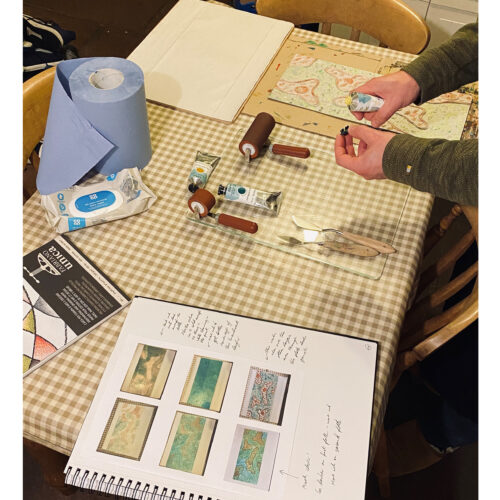
Printmaking studios at home
During covid lockdown I’ve been so grateful I have a studio space at home. I was reflecting how my OCA students use their homes as studios.
I asked a number of printmaking students to reflect and share how they made printmaking spaces within their homes. I’m very grateful for their sharing and advice, including many things I had not thought of.
Printmaking can be undertaken successfully in a garage, kitchen and even a bedroom with a little adaptation.
I asked the following questions to Angela Mullins, Norman Sanderson, Lami Mulvey and Steve Meyfroidt. Their insightful and helpful replies are below.
How did you make a space for printmaking at home?
Angela Mullins: “I straight away earmarked the smallest bedroom as my dedicated creative space. It occasionally doubles as an office or a spare room but usually its where all my creative practice takes place”
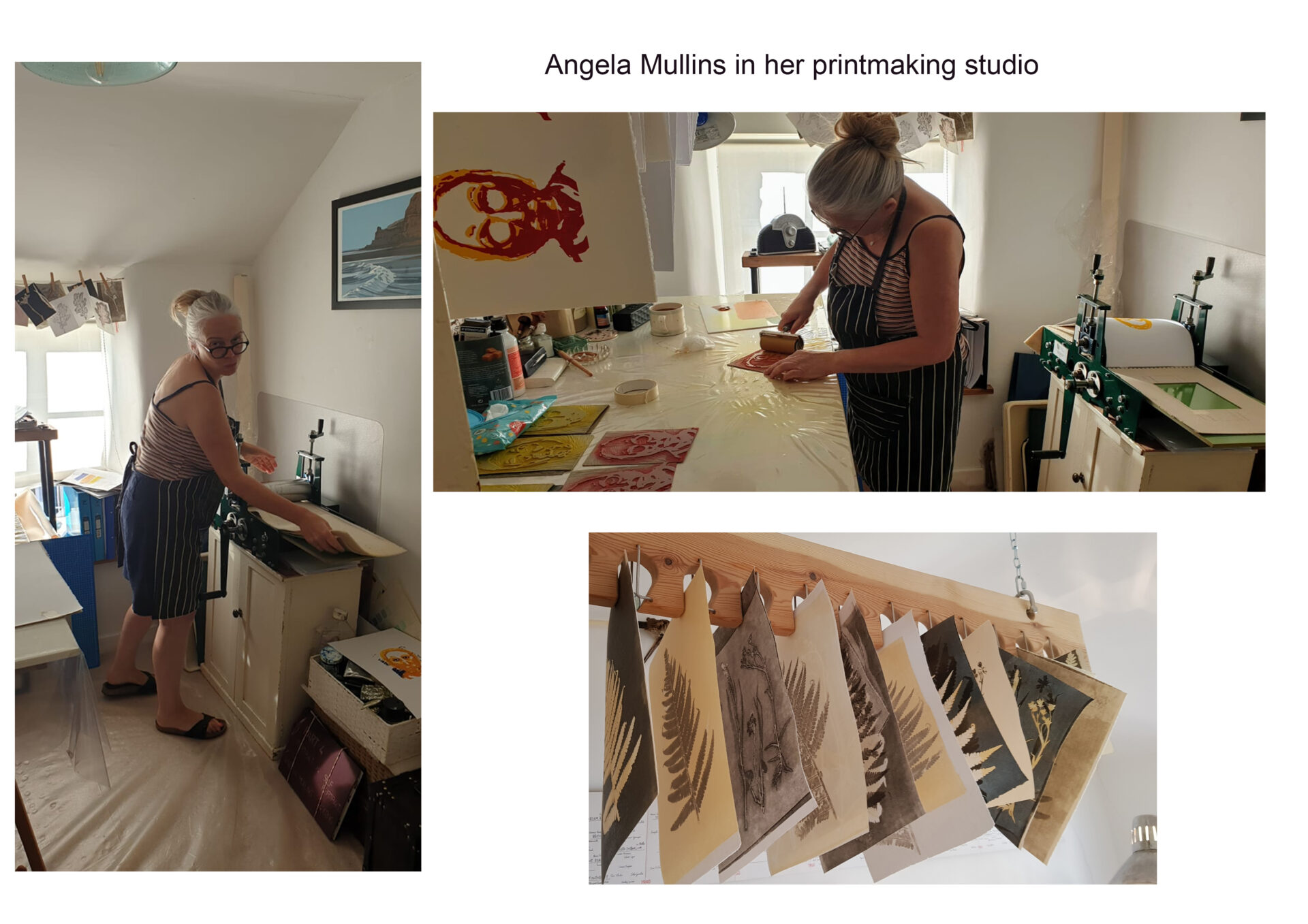
Steve Meyfroidt: “As a newcomer to printmaking, I have no space for a permanent printmaking area so I use my kitchen table”
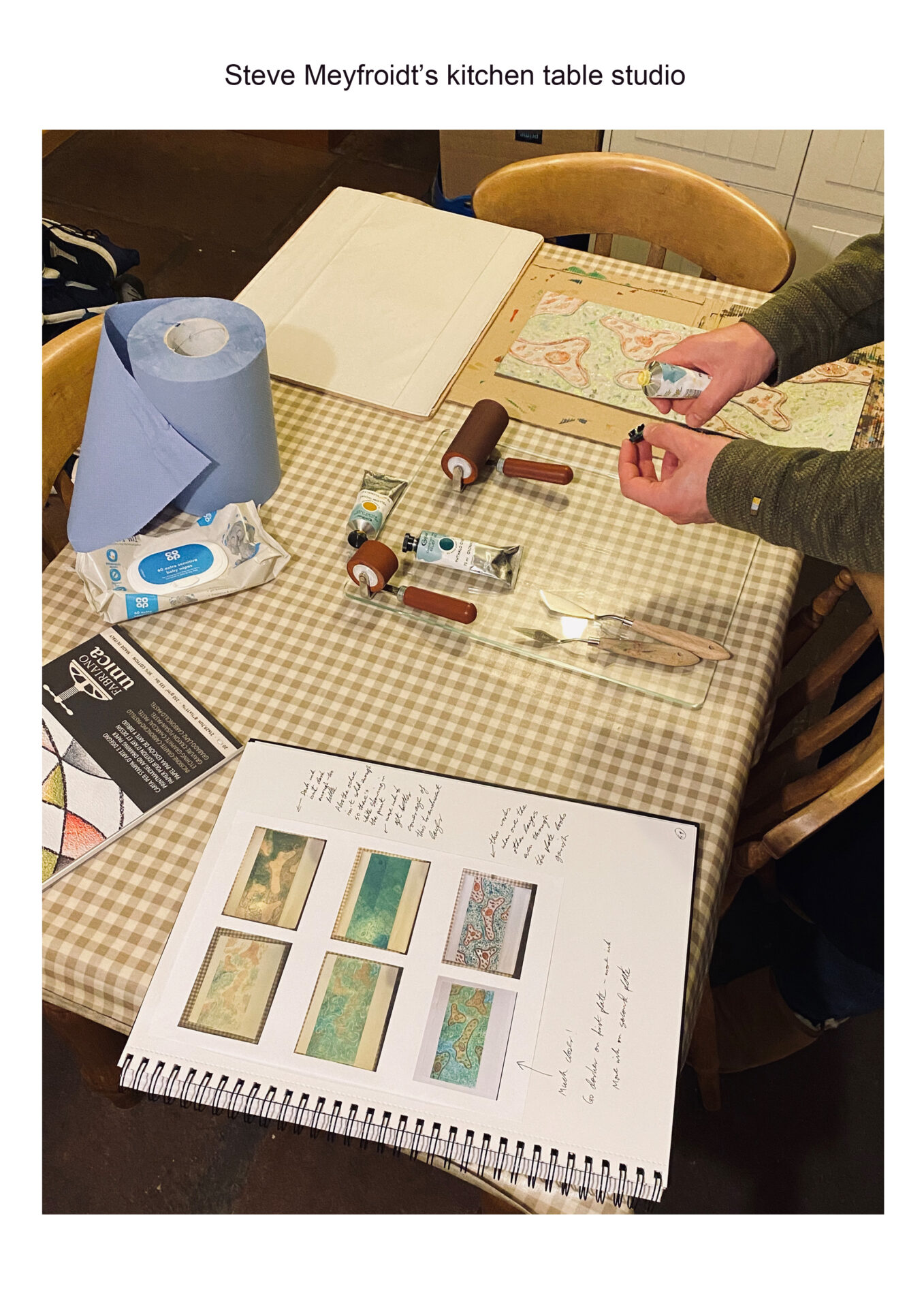
Lami Mulvey: “I started printmaking with wood engraving as it can be done in a small space with a minimum of equipment and especially with no requirement for a press – they can be hand burnished using the back of a wooden spoon. The only viable place in my home was at the window of my not-so-large bedroom. I begged and borrowed a couple of tables to work at, got an adjustable chair from a junk shop, and a neighbour gave me lots of wooden shelving. Then another neighbour turned up with an old bookbinding press (this doesn’t really press prints evenly but can be used as a supplementary method, and can flatten out curling paper etc.)”
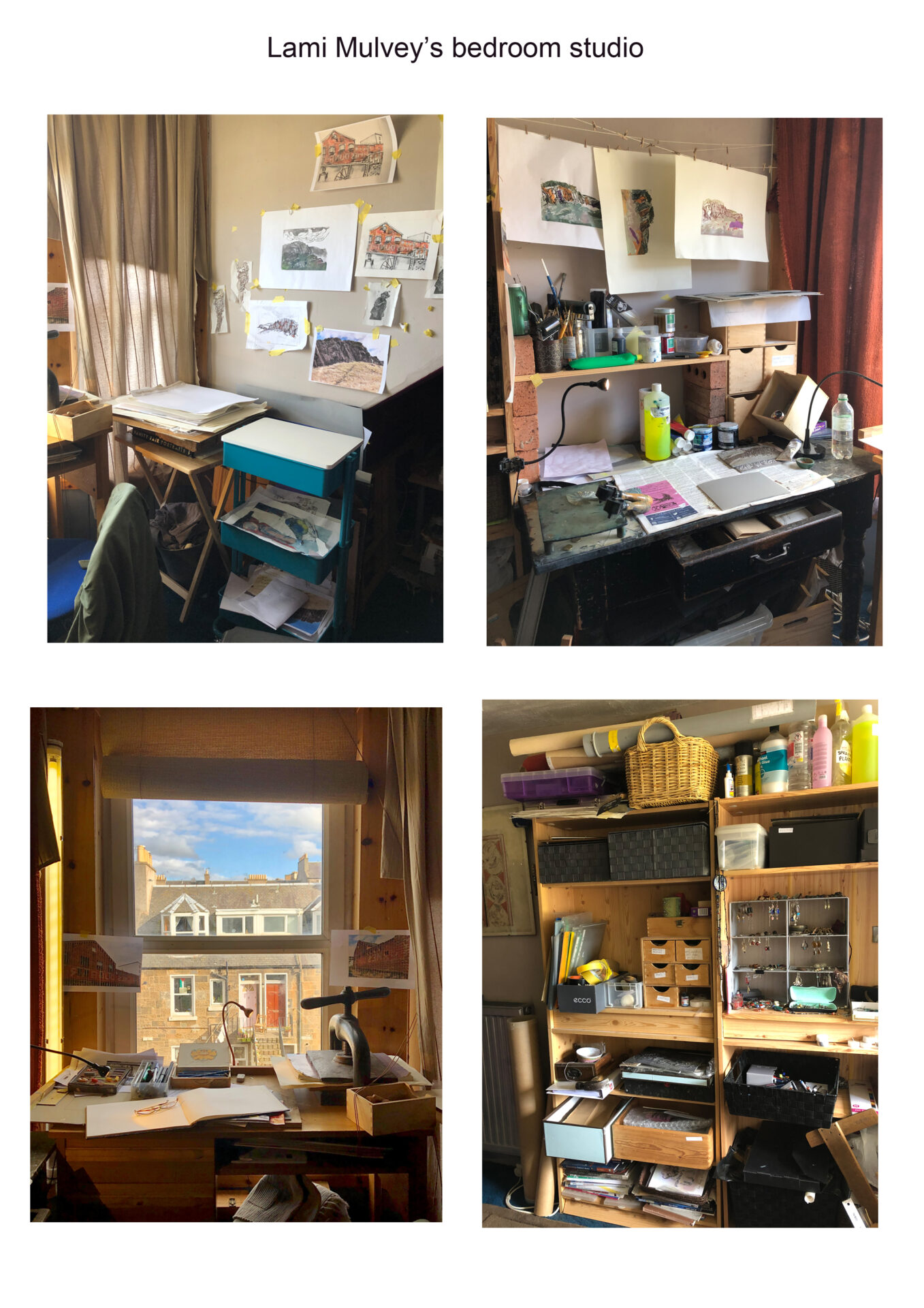
Norman Sanderson: “I had converted my garage into a workshop about 15 years ago and made a large bench for woodworking and other interests. I also have a study with adequate work surface and shelving to accommodate art activities”
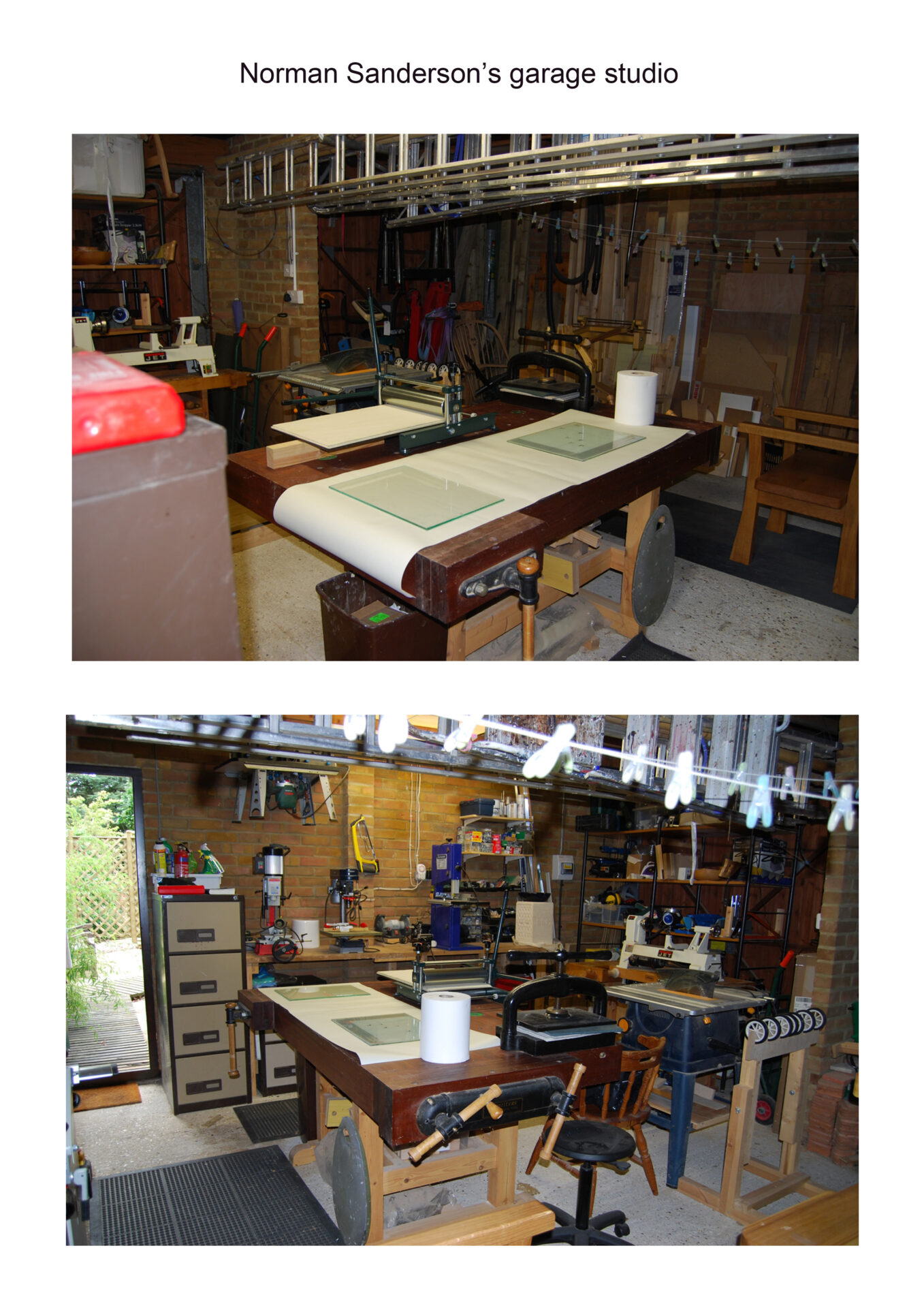
Was it easy to adapt a space for printmaking?
Angela Mullins: “It’s a small room with limited natural light from a small cottage window & with low ceilings it can get stuffy, but so much easier having everything I need in one place rather than using a shared space in the house. It also means I can walk away from whatever I’m doing without having to clear it all away, shut the door & it’s not in anyone else’s way. It’s something I find invaluable & I’m very grateful to have it”
Lami Mulvey: “It was quite easy for me to adapt the space as I’m not particularly fussy about the appearance of my bedroom. It is cluttered and chaotic, but that’s all right with me”
What would you recommend for other students considering undertaking printmaking?
Angela Mullins: “To buy the best equipment they can afford but take advice & do the research before splashing out, use open forums & social media etc to find out what might be the best items to start with, look for second-hand equipment. To be organised & not get frustrated by the space they have, printmaking deserves time & consideration & as I’m usually over keen to get stuck in I’ve found stopping to look for something often leads to time for additional thoughts & ultimately might send me off in a different course”
Lami Mulvey: “It’s a fantastic way of using your creative energy, adaptable, fun, and there are a multitude of techniques to learn. It’s addictive!”
Steve Meyfroidt: “Don’t worry about having a large permanent space because you’ll work within the constraints that you have. Ideas are more important than equipment.
However, consider how you intend to dry your fresh prints; oil-based inks take time to dry so can you arrange a temporary washing line in a corner somewhere to peg up prints to dry for a few days?
And look into local printmaking studios that you may have access to. Apart from the equipment that’s available, you’ll also have access to expertise”
Is there anything you would do differently if you had your time again?
Angela Mullins: “I started out in a garden shed space with no insulation, heating or water supply. Believe me, it’s difficult to work in freezing temperatures! And I often ended up very demoralised with numb fingers & a blanket round my shoulders, so I think I’d have been better to make space in my house even if it was in a shared space”
Norman Sanderson: “Perhaps travel further to do short courses more. I did go art galleries/exhibitions to see prints and will continue to do so. It helps to see the outcome of the processes used as well as appreciating the artistic content”
Have you got access to a press?
Angela Mullins: “Yes, I have the portable Hawthorn etching press, something I was lucky to find second hand, plus an Xcut Xpress machine adapted with blankets, a great little portable press”
Lami Mulvey: “I can’t use the local Printmakers Workshop for a number of reasons (I can’t always get away from home and can’t afford it on a regular basis). I need to be able to work in an ad hoc way in my own home. So it’s hand burnishing for me”
Did you encounter any difficulties making a home printmaking studio?
Angela Mullins: “Not really. Making art, being generally creative & having a dedicated space to do that in has become essential over the years so whenever I’ve moved to a new house it takes a high priority to work that out early on”
Lami Mulvey: “I didn’t have too much of a problem converting my bedroom as I have never really had a typically nicely furnished bedroom. It has always simply been a place to work and sleep. I gathered rather than bought most things. It has expanded more and more but I don’t really mind as long as my bed still fits. It’s really my only option so I’ve had to learn to love it, and my husband tolerates it”
Did you enjoy making prints?
Angela Mullins:” I love it! Working out the technical aspects can be frustrating at times, but the rewards are worth it. The ability to manipulate & combine many different printmaking techniques offers such a variety that I wouldn’t dream of sticking to just one medium now”
Norman Sanderson: “I thoroughly enjoy the processes and often pleasantly surprised by the outcome”
Steve Meyfroidt: “Absolutely yes. It’s added a dimension to my practice that I intend to carry forward on the Drawing pathway that I’m following”
Lami Mulvey: “Always!”
Was printmaking messy?
Angela Mullins: “Printmaking was very messy for me at the beginning! But over time I’ve learnt to be organised, setting out the tools I’ll most likely need before I start, trying hard not to waste ink so only using what I need, plus keeping my wet & dry areas completely separate & clearing up any mess immediately. Being organised is vital in order to keep my final prints clean”
Steve Meyfroidt: “It can get messy very quickly unless you keep some control over things. Baby wipes are a godsend. I use inks that clean up in water (Schminke, Akua and Caligo Safewash). I wouldn’t use oil-based inks at home, for fear of the tidy up, but I’d like to try them when I have access to a print studio.
If I was starting again, I’d buy Caligo Safewash and build up a good collection of colours from that range”
Norman Sanderson: “I found it difficult at first when I was using solvents to clean the printing plates and tools but found it much easier when I switched to using cheap cooking oil. I found that it does not have to be messy if you are careful”
How did you dry your prints?
Angela Mullins: “I have a Print Ball Drying Rack from Lawrence Art Supplies. It doesn’t leave imprints on the paper & is easy to use, it hangs over my workbench so I can just push a print in & easily release it when I need to. I used to use adapted clothes pegs & line, which was fine in the beginning, but this drying rack really is better.
Norman Sanderson: “At present, I hang wet prints from pegs on strung lines in the garage and study but would like to find a dust free space for a horizontal drying rack. My main storage area is in portfolios under my bed”
Lami Mulvey: “I strung some string across a corner of my room like a clothesline and use wee Hobbycraft pegs to hang prints up. I also use masking tape on a wall”
What was the best thing about studying printmaking?
Angela Mullins: “There are so many things I didn’t even know existed! I’d never have discovered half of them on my own. From cyanotype to etching, from chine–collé to collatype, but the best thing for me is there is no limit, this is a blossoming artistic field & the potential for exploration & redefinition is losing all boundaries”
Steve Meyfroidt: “Learning an entirely new field that’s opened up my drawing practice to techniques with new risks and new approaches to making images. It’s shown me options that I’ll follow up as I continue down the drawing pathway”
Are there any comments you’d like to make about working from home and your home studio?
Angela Mullins: “I can’t compare working from a home studio to an offsite studio as I’ve always worked from home, but I think I’d prefer having my work near me than in another building somewhere. If I suddenly think of something, or want to regularly check up drying prints say, to be able to nip in the studio & do that is so convenient, plus it doesn’t matter what time of day or night I want to work, or even I’m still in my pj’s!
It’s important to make the space somewhere that brings a smile to your face every time you walk in, make it a creative space, hang things up, have a pin or wipe board to stick your thoughts on, basically keep things in such a way as to inspire your creativity every time you open the door. I love my creative space!”
Lami Mulvey: “Only that it depends on your priorities, your commitment, your time and your values (and the tolerance of your family) how much the whole experience encroaches on your life and your space. I’ve found it all manageable, but sometimes not easy”
Norman Sanderson: “Visit established printmakers and see their studios before you start”
Find out more about Printmaking at OCA here.
|
|







Loved seeing everyone’s adapted printmaking studios. Some really great ideas here, especially regarding visiting a printmaking studio first. There are plenty of YouTube videos of printmakers in their studios to give you ideas (if visiting one is not an option) and keep checking eBay for materials and equipment. Printmaking is a hidden gem regarding the extensive amount of processes and combinations with other subjects, which can be developed.